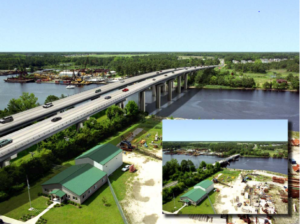by James A. Bacon
The McDonnell administration has closed its first major transportation-funding deal with the newly created Virginia Transportation Infrastructure Bank (VTIB): a $412 million bridge-building project in Chesapeake. The mission of the VTIB is to back important transportation projects that could not get financing otherwise.
The Dominion Boulevard project will replace an old, two-lane drawbridge with a four-lane, high-rise bridge over the Elizabeth River and make related improvements to the road. In a presentation to the Commonwealth Transportation Board Wednesday, city officials described the so-called “boulevard” as one of the most heavily traveled two-lane roads in the state. Traffic averages 33,000 vehicles per day. Moreover, the drawbridge opens 6,000 times a year to allow boats to traverse the Intracoastal Waterway. The result is frequent, unpredictable and horrendous traffic jams.

The Dominion Boulevard project marked in green. Existing Dominion Expressway shown in blue. (Click for larger image.)
Not only is the road a vital transportation conduit for local traffic, it is part of the Norfolk-to-Raleigh connector linking the Hampton Roads interstate network with the North Carolina capital. “Dominion Boulevard is the number one traffic priority in Chesapeake,” said City Manager William E. Harrell.
The city pursued other avenues of financing but could not pull if off. The federal government turned down a request to back the project with much sought-after Transportation Infrastructure Finance and Innovation Act (TIFIA) loans. And it was impossible to raise the money in the bond market at investment-trade interest rates.
To make the project more attractive to investors, Chesapeake combined the existing Chesapeake Expressway, a 10-mile toll road that provides access to the Outer Banks, with the Dominion Boulevard project in order to take advantage of the credibility the Expressway has built up in successfully supporting its debt. Still, the bridge toll revenue will not provide sufficient coverage to win an investment-grade credit rating on the debt.
Under the deal worked out between the city, the state and BB&T Capital, the state will back $152 million in project debt at a below-market rate of 3.3%. The debt will be subordinated, which means that if there is any shortfall in toll revenues, private investors will be paid their interest and principle before the state will. That added protection for investors will enable the city to sell $227 in Baa1-rated bonds. The balance of the project will be paid for with conventional state funding.
Commonwealth Transportation Board members asked how the state might be impacted if toll revenues fell short. Revenues would be applied to paying the interest first, and unpaid principal would be tacked onto the loan, in effect extending the life of the loan. There is considerable flexibility built into the terms and conditions, said David Tyeryar, deputy secretary of transportation. “We’ve been very conservative.”
Loan repayment will be cycled back into the infrastructure fund to be used for other projects. A second municipality has applied for VTIB funding, and state officials said there is enough money in the infrastructure bank to provide the financing, assuming the project meets state criteria.
City and state officials did not discuss the toll rate that would be charged and the extent to which, if any, state financial support was needed to “buy down” the rate. I did question City Manager Harrell about the traffic-volume assumptions built into the financial projections. He confirmed that the financing assumes considerable traffic growth, even in the face of national and statewide declines in Vehicle Miles Traveled in recent years. The project will open up considerable land for development, which should generate more traffic, Harrell said.



